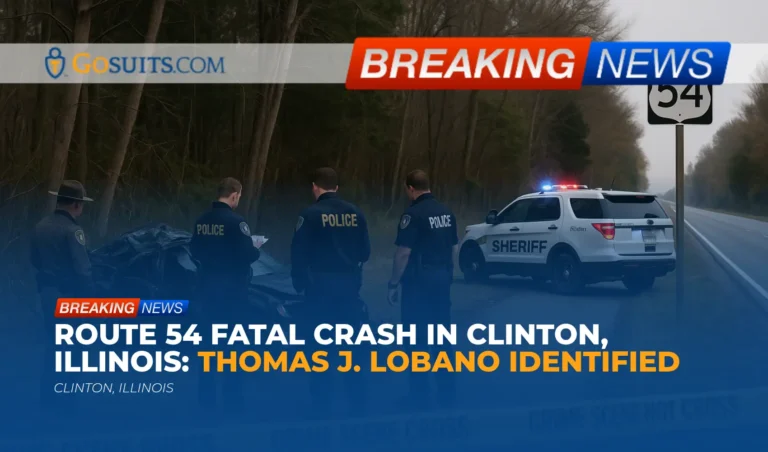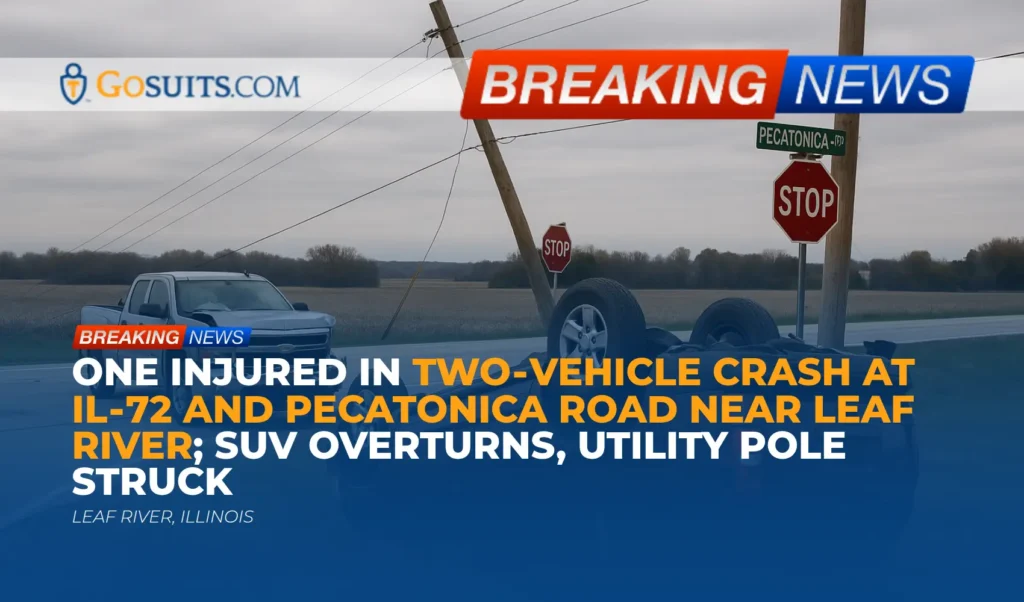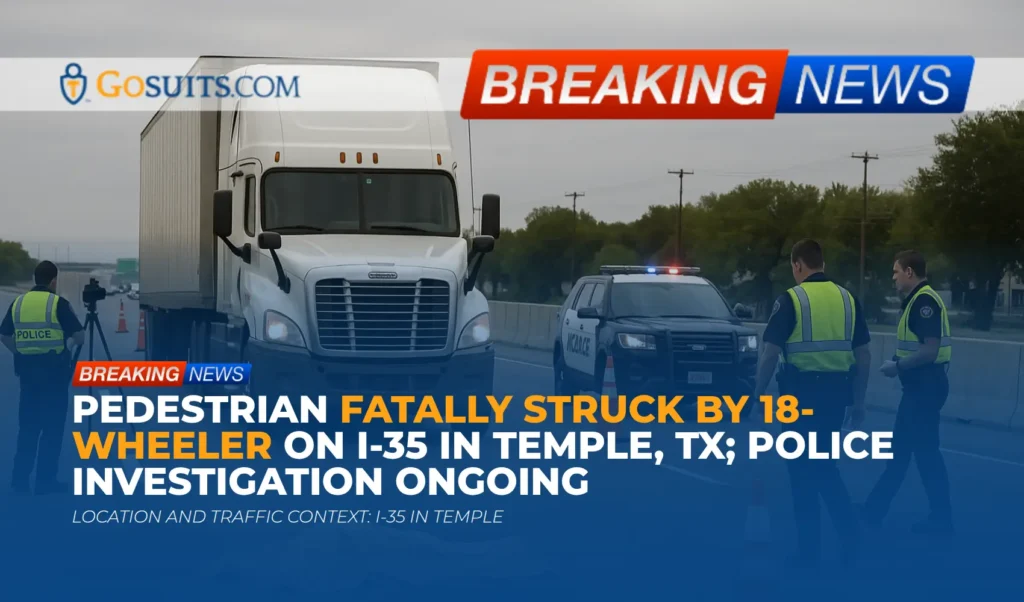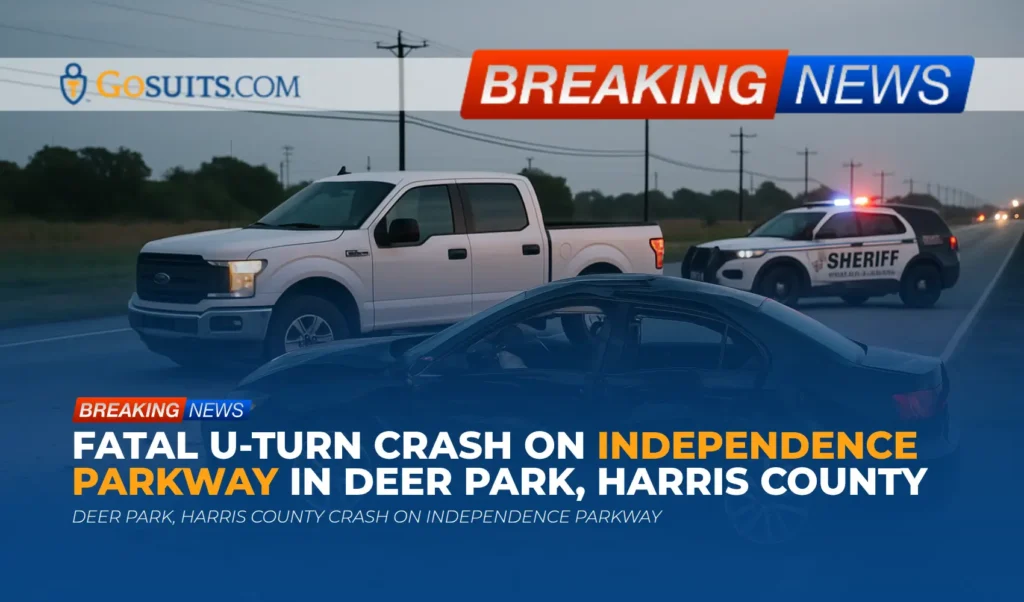- What we know about the Route 54 crash in Clinton, Illinois
- Agencies involved and current status of the investigation
- How to obtain key records and information
- Safety context: single vehicle roadway departure crashes
- Civil legal considerations in Illinois after a fatal single vehicle crash
- Insurance and coverage issues in Illinois
- Preserving evidence and protecting rights
- Time limits that may apply in Illinois
- Practical next steps for those affected
- Commentary from Gosuits Clinton, Illinois Personal Injury Attorney
- Why timely action matters
What we know about the Route 54 crash in Clinton, Illinois
Authorities have identified the victim of a single vehicle crash on Route 54 West in Clinton, Illinois, as 29-year-old Thomas J. Lobano of Clinton. According to the DeWitt County Coroner, he was pronounced deceased at the scene at 7:28 p.m. on October 20, 2025. Early information indicates the vehicle was traveling westbound toward Clinton when it left the roadway and entered a wooded area on the north side of Route 54.
The incident remains under investigation by the DeWitt County Coroner’s Office, the DeWitt County Sheriff’s Department, and the Illinois State Police. At this stage, authorities have not publicly released contributing factors such as potential roadway conditions, mechanical issues, or other circumstances. It is common for full investigative results to take weeks or months as agencies complete scene analysis, toxicology, autopsy, and any data downloads from vehicle systems.
Out of respect for those impacted, this article focuses on the process that typically follows a fatal crash, what records may be available, safety context for single vehicle roadway departure crashes, and general civil legal considerations in Illinois.
Agencies involved and current status of the investigation
In a fatal crash in DeWitt County, several agencies can play roles at different stages. Understanding who does what can help families navigate the process and anticipate which office to contact for specific records or updates.
DeWitt County Coroner’s Office
The coroner coordinates the death investigation, confirms identity, determines cause and manner of death, and may conduct or oversee an autopsy. In Illinois, coroners may also convene an inquest in certain cases. The Illinois Coroner statutes are found in the Counties Code at 55 ILCS 5. Families often receive information about autopsy and toxicology timelines and the process for obtaining reports from the coroner’s office once results are finalized.
DeWitt County Sheriff’s Department
The sheriff’s office may handle initial response, secure the scene, assist with traffic control, collect evidence, and document observations. Depending on the location and circumstances, they may work closely with the Illinois State Police on crash reconstruction. Requests for certain records may be subject to the Illinois Freedom of Information Act, or FOIA, found at 5 ILCS 140.
Illinois State Police
The Illinois State Police often provide crash reconstruction, measure and map scenes, and compile crash reports. Families and authorized representatives can request crash reports through the State Police portal at isp.illinois.gov/CrashReports. Certain supporting materials, like photographs or supplemental narratives, may be available through FOIA or direct request after the investigative phase.
It is common for agencies to withhold some records until the investigation is complete. When an investigation is active, Illinois FOIA allows agencies to delay release of certain records if disclosure could interfere with pending proceedings or compromise the investigation. See exemptions in 5 ILCS 140.
How to obtain key records and information
Several types of records can help families understand what happened and support insurance claims or civil actions. Below is a general overview of what exists and where to start. Timelines for availability vary, and some materials are released only after investigative steps are finished.
Traffic crash report
The official crash report typically documents the location, time, parties involved, initial observations, roadway conditions, and any citations or notes. For crashes investigated by the Illinois State Police, requests can be made at isp.illinois.gov/CrashReports. If the sheriff’s office is the custodian, a FOIA request may be necessary under 5 ILCS 140.
Coroner documents and autopsy report
The coroner’s file may include the death certificate worksheet, autopsy report, toxicology results, and an inquest record if applicable. Access and timing are guided by Illinois law, including provisions of 55 ILCS 5 and the state FOIA at 5 ILCS 140. Families can contact the coroner’s office to learn when results will be finalized and how to request copies.
Death certificate
Certified death certificates in Illinois are issued through the Illinois Department of Public Health. Guidance on eligibility, fees, and ordering is available at the Illinois Department of Public Health’s Vital Records page: dph.illinois.gov/topics-services/birth-death-other-records/death-records.html. Funeral homes often assist with initial requests.
911 audio, dispatch logs, and CAD records
Emergency communications recordings and dispatch logs can provide a precise timeline. These are generally requested from the local public safety answering point under 5 ILCS 140. Some portions may be redacted to protect private information or ongoing investigations, as allowed by law.
Vehicle inspection and event data recorder
Many vehicles contain an event data recorder, often called the EDR or black box. Federal regulations describe EDR data elements at 49 CFR Part 563. Data can include pre-crash speed, braking, seat belt status, and airbag deployment. If a vehicle is impounded, storage facilities or agencies may require written permission or a court order to preserve and download data. Timely preservation is crucial because batteries can lose power and data can be overwritten.
Roadway and maintenance records
If roadway condition, signage, lighting, or guardrails could be factors, maintenance logs, prior incident records, and engineering files may be relevant. Depending on jurisdiction, records may be held by a municipality, county highway department, the Illinois Department of Transportation, or the State. Many statewide resources are available through IDOT. Requests can be made under FOIA for public bodies.
Safety context: single vehicle roadway departure crashes
A single vehicle roadway departure crash occurs when a vehicle leaves its travel lane or roadway, often resulting in collisions with trees, utility poles, embankments, or rollovers. These events can be severe due to high speeds, lack of energy-absorbing barriers, and limited time for drivers to recover.
Nationally, single vehicle crashes account for a significant share of traffic fatalities each year. Federal traffic data compiled by the National Highway Traffic Safety Administration indicates that a large proportion of roadway deaths involve a single vehicle and often include roadway departure. NHTSA publishes annual crash data and analysis in its Traffic Safety Facts series at nhtsa.gov.
The Federal Highway Administration highlights that roadway departures remain a major safety concern and promotes proven countermeasures such as enhanced curve signage, high friction surface treatments, shoulder and centerline rumble strips, and improved guardrail designs. Resources on roadway departure safety and strategies are available at the FHWA site: highways.dot.gov.
General risk factors associated with roadway departure crashes, according to federal safety resources, include:
- Curves and geometry – Tighter curves and limited sight distance can increase crash risk if speeds are too high for conditions.
- Speed – Higher speeds reduce the time to react and increase crash severity. See NHTSA speeding resources at nhtsa.gov.
- Impairment and fatigue – Impaired or drowsy driving can contribute to lane departures. NHTSA provides data on impairment and drowsy driving at nhtsa.gov.
- Road surface conditions – Wet, icy, or debris-strewn roads can reduce traction, as discussed in FHWA roadway safety resources at highways.dot.gov.
- Infrastructure – Inadequate signage, missing guardrails, or drop-offs can worsen outcomes when vehicles leave the roadway.
- Vehicle factors – Tire condition, braking systems, steering, and stability control features can influence crash avoidance and severity. NHTSA vehicle safety information is available at nhtsa.gov.
None of these factors should be presumed to have played a role in the Clinton crash without official findings. They are included here to provide context on the types of circumstances investigators evaluate in roadway departure events.
Civil legal considerations in Illinois after a fatal single vehicle crash
When a single vehicle crash results in a fatality, families often face difficult questions about why it happened and whether any person or entity may be legally responsible. Illinois law provides avenues for civil claims in certain circumstances. The discussion below is general information about common paths that may be considered after investigations conclude.

Illinois Wrongful Death and Survival statutes
Two Illinois statutes often come into play:
- Wrongful Death Act – The decedent’s personal representative may bring a claim for the exclusive benefit of surviving spouse and next of kin for losses that include pecuniary injuries and grief and sorrow. See 740 ILCS 180.
- Survival Act – Allows recovery for claims the decedent could have brought had they lived, including conscious pain and suffering and certain medical expenses. See 755 ILCS 5/27-6.
These statutes allocate recoveries and outline who may bring claims. The probate court may need to appoint a personal representative if one is not already established.
Potential liability theories in single vehicle cases
Although some single vehicle crashes involve no third-party civil liability, others may involve legally responsible parties. Without speculating about this specific crash, examples of potential civil claims include:
- Roadway design or maintenance issues – Claims may arise if a public entity failed to maintain reasonably safe roads for intended users, such as missing or obscured signs, dangerous shoulder drop-offs, or defective guardrails. Illinois public entity duties and certain immunities are addressed in the Local Governmental and Governmental Employees Tort Immunity Act at 745 ILCS 10, including the statute of limitations provision at Section 8-101.
- Vehicle defects – Manufacturing or design defects in critical systems like tires, brakes, or steering can contribute to roadway departures. NHTSA maintains recall information and defect investigations at nhtsa.gov/recalls.
- Negligent maintenance or repair – Improper service by a repair facility could create mechanical failures.
- Negligent entrustment or ownership issues – If a vehicle owner allowed operation despite known safety issues, claims may be evaluated depending on facts.
- Third-party negligence upstream – In rare situations, actions by another driver or entity may force evasive maneuvers that lead to a single vehicle departure even without a direct collision. Witness statements, camera footage, and EDR data can be important here.
Any evaluation of these theories requires careful review of official reports, physical evidence, and applicable immunities or limitations under Illinois law.
Claims involving public entities
If a county, municipality, or other local public entity is potentially involved, the Tort Immunity Act at 745 ILCS 10 contains defenses and immunities that may apply, as well as specific timing rules. Different rules can apply to the State of Illinois itself, where claims typically proceed in the Illinois Court of Claims under the Court of Claims Act at 705 ILCS 505.
Insurance and coverage issues in Illinois
Illinois is a fault-based state for auto insurance. After a crash, insurance questions often include what coverages apply and what steps are appropriate. Before speaking with any insurance company, it is prudent to consult with a qualified attorney for a free consultation to understand rights and obligations. Statements to insurers can be used later and may affect the outcome of claims.
Required coverages and common policy types
- Liability coverage – Illinois requires auto liability insurance to cover injuries and property damage caused to others. See consumer guidance from the Illinois Department of Insurance at insurance.illinois.gov.
- Uninsured motorist coverage – Illinois requires uninsured motorist bodily injury coverage in at least minimum limits, with underinsured motorist coverage generally offered. See the Department of Insurance consumer information at insurance.illinois.gov.
- Medical payments coverage – Optional first-party coverage that can help with medical bills regardless of fault.
- Collision coverage – Optional coverage for damage to the insured vehicle.
In a fatal single vehicle crash, policy questions can include whether any third party may be liable, whether a product defect implicates a manufacturer’s policies, and how first-party benefits apply. The wording of each policy matters.
Communicating with insurers
When claims are involved, insurers often request recorded statements, authorizations, or medical and coroner records. It is advisable to consult an attorney first before speaking with insurers. What is said can be used later, and broad authorizations can sometimes disclose more than necessary. Document all communications and keep copies of any materials provided.
Preserving evidence and protecting rights
The period immediately after a serious crash is when crucial evidence is most vulnerable to loss. Practical steps can help preserve information regardless of whether a claim is eventually pursued.
- Secure the vehicle – Identify the storage location and request that no repairs or alterations be made. If possible, put requests in writing. If there is potential for a product defect claim, ensure the vehicle and key components are preserved for inspection and EDR data download. See EDR background at 49 CFR Part 563.
- Request official reports – Obtain the crash report when available from the Illinois State Police at isp.illinois.gov/CrashReports and inquire with local agencies as needed.
- Preserve scene information – If safe and permitted, photograph the area, skid marks, gouges, damaged roadside features, and any signage or lighting conditions. Note weather and visibility.
- Identify potential witnesses – Record names and contact information for anyone who saw the vehicle before or during the crash, or who arrived shortly after.
- Collect maintenance and recall records – Gather service history, receipts, and recall notices. NHTSA recall lookups are available at nhtsa.gov/recalls.
- Request 911 and dispatch records – Use Illinois FOIA at 5 ILCS 140 to request audio and CAD logs where appropriate.
If there is any possibility of a claim involving a public entity or the State of Illinois, additional notice and timing rules may apply, making early legal consultation especially important.
Time limits that may apply in Illinois
Illinois law imposes deadlines for bringing claims. Missing a deadline can bar recovery, so identifying applicable time limits early is important. The exact deadlines depend on who the claim is against and the type of claim, and exceptions may apply in specific circumstances.
- General limitations period – Many personal injury and wrongful death claims in Illinois must be filed within two years of the date of injury or death, subject to specific statutes. The Illinois Wrongful Death Act is at 740 ILCS 180.
- Claims against local public entities – Claims against counties, municipalities, and other local entities may be subject to a one-year statute of limitations under Section 8-101 of the Tort Immunity Act at 745 ILCS 10/8-101.
- Claims against the State of Illinois – Many claims must be filed in the Illinois Court of Claims per the Court of Claims Act at 705 ILCS 505. The Act contains specific time and notice provisions, including requirements that a claim be filed within two years and that notice be filed within one year unless the claim itself is filed within that one-year period. There are exceptions for certain circumstances.
These time limits can be complex, particularly where multiple parties or governmental entities are involved. Because the consequences of a missed deadline are severe, early review of the facts and potentially applicable statutes is essential.
Practical next steps for those affected
In the aftermath of a fatal roadway departure crash, there is often a long list of tasks alongside grieving and supporting loved ones. The following steps are general suggestions to help organize information and protect options while respecting ongoing investigations.
- Coordinate with the coroner – Ask about expected timelines for autopsy and toxicology, whether an inquest will be held, and how to request copies once released. Refer to coroner authorities under 55 ILCS 5.
- Order certified death certificates – Follow guidance from the Illinois Department of Public Health at IDPH Vital Records.
- Request the crash report – Monitor availability and request the report from the Illinois State Police at isp.illinois.gov/CrashReports.
- Preserve the vehicle – Locate where the vehicle is stored and request that it not be altered. Consider arranging an independent inspection and EDR download with appropriate permissions. See EDR reference at 49 CFR Part 563.
- Identify potential scene evidence – Photograph the area when permitted, especially if storms or maintenance could change conditions.
- Gather personal and vehicle records – Insurance policies, maintenance records, and any aftermarket modifications can be relevant.
- Avoid early broad statements to insurers – Before contacting any insurance company, seek a free consultation with an attorney to understand rights and potential impacts. What is said to insurers can be used later.
- Consider emotional support resources – Federal and state resources exist for grief and crisis support. General information is available from samhsa.gov, which administers the 988 Lifeline.
Every situation is unique. The priority is safety, care for those impacted, and thoughtful steps that preserve important information while staying aligned with the law and ongoing investigations.
Commentary from Gosuits Clinton, Illinois Personal Injury Attorney
We extend our sincere condolences to the family, friends, and community members mourning the loss reported on Route 54 West in Clinton. This discussion is intended for general information and education during a difficult time, and it reflects common civil legal and insurance issues that can follow a roadway departure crash.
From a civil perspective, single vehicle fatalities present complex questions. Investigations often examine multiple layers: whether roadway geometry or maintenance contributed, whether any mechanical defect or recall may have played a role, and whether another road user indirectly triggered evasive action. EDR data, scene measurements, signage and guardrail conditions, and coroner findings can each inform a careful analysis. It is important to avoid assumptions until official reports are complete.
Insurance companies and large corporations involved in claims sometimes leverage the information gap that follows a tragedy. Adjusters may request broad medical or coroner authorizations, suggest early statements, or offer quick resolutions before full facts or damages are known. Policies contain technical exclusions and endorsements that can affect coverage in ways that are not obvious at first glance. A measured approach helps ensure that rights are not unintentionally compromised and that decisions are made with a full picture of the evidence and applicable law.
A free consultation with a seasoned attorney provides a confidential setting to understand options, potential timelines, and evidence preservation needs without making any commitments. Early guidance can be especially important if a public entity or the State of Illinois could be involved, because special notice and filing rules may apply.
Why timely action matters

What to do
- Request and organize official records – Obtain the crash report, certified death certificates, coroner documents when available, and any 911 or dispatch materials allowed by law.
- Preserve physical evidence – Secure the vehicle and critical components, request non-alteration in writing, and consider an independent EDR download and inspection.
- Document the scene and circumstances – Capture photographs and notes while roadway markings or conditions remain unchanged.
- Consult an attorney before speaking with insurers – Seek a free consultation to understand rights, policy language, and potential impacts of recorded statements or broad authorizations.
- Calendar key time limits – Note that different deadlines may apply for claims involving public entities or the State of Illinois.
Why it matters now
- Evidence can disappear quickly – Tire marks fade, debris is cleared, weather alters conditions, and vehicles may be repaired or salvaged. Early preservation safeguards critical facts.
- EDR data is time-sensitive – Event data recorders depend on battery power and can be overwritten. Prompt action can capture pre-crash data that may never be recoverable later.
- Insurance interactions start early – Adjusters may seek statements or authorizations soon after an incident. Informed choices help prevent unintended waivers or admissions.
- Shorter deadlines may apply – Claims against local public entities often carry a one-year limitation, and claims against the State have unique Court of Claims rules. Missing a deadline can end a claim before it starts.
- Clarity supports better decisions – Organizing records and understanding the process reduces uncertainty and helps align choices with long-term needs.
Key government and educational resources
- Illinois State Police Crash Reports
- Illinois Wrongful Death Act, 740 ILCS 180
- Illinois Survival Act, 755 ILCS 5/27-6
- Tort Immunity Act statute of limitations, 745 ILCS 10/8-101
- Court of Claims Act, 705 ILCS 505
- Illinois Freedom of Information Act, 5 ILCS 140
- IDPH Death Records
- NHTSA Fatality Analysis Reporting System
- FHWA Roadway Departures Safety
- 49 CFR Part 563 EDR
- Illinois Department of Insurance
- SAMHSA 988 Lifeline information






